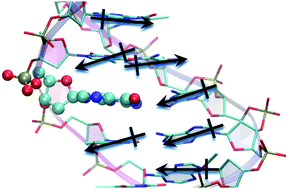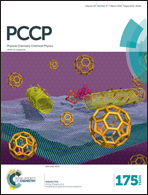The effect of sequence on the ionization of guanine in DNA†
Abstract
The accurate estimation of the ionization energies and understanding the nature of the ionized states of the nucleic acid bases (NABs) are crucial to the understanding of the DNA damage mechanism. The vertical ionization energy (VIE) of guanine is the lowest among the NABs and the ionization energies are strongly affected by the environment, such as solvation and characteristics of nearby NABs. Therefore, we investigate the sequence dependence of the VIEs of guanine in B-DNA. We use the equation of motion coupled cluster method for the estimation of ionization potential with single and double excitations (EOM-IP-CCSD) and density functional theory with dispersion corrected ωB97x-D for the estimation of VIEs. A significant amount of non-additivity or cooperativity, directly proportional to charge delocalization, is noticed in the change in VIE due to the interaction with the nearby NABs. While the change in VIE due to base pairing originates predominantly from charge–dipole interactions, stacking between base pairs is a more complicated balance of dispersion and charge–dipole interactions as well as stabilization due to the delocalization of the positive charge. The long range interactions are however dominated by 1/r3 distance dependence which shows the major role played by charge–dipole interactions. The extent of localization of positive holes on guanine is also estimated for various sequences.

- This article is part of the themed collection: PCCP Emerging Investigator Lectureship Award Winners

 Please wait while we load your content...
Please wait while we load your content...